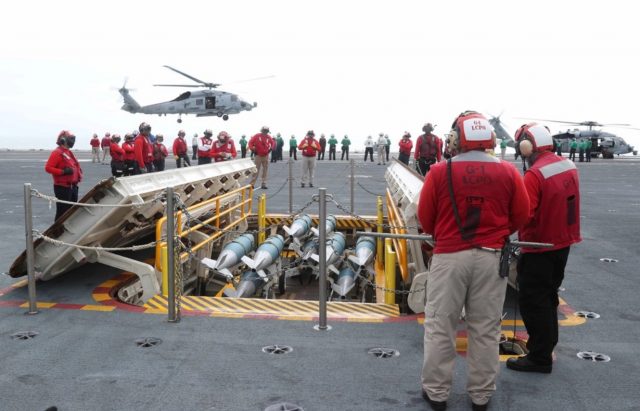
The lead ship of the next generation of US Navy aircraft carriers can now finally use all of its 11 weapons elevators, four years after it entered service.
The US Navy announcement on the successful rectification of the issue comes ahead of a planned 2022 maiden operational deployment of USS Gerald R. Ford.
According to the Naval Sea Systems Command, the 11th and final Advanced Weapons Elevator (AWE) aboard USS Gerald R. Ford (CVN 78) was turned over to the ship’s crew on December 22. In April 2020, the crew had five functional elevators at their disposal.
AWE is one of 23 new technologies developed for the carriers, and one of the three more controversial ones that have pushed the first deployment date out to at least late 2022. The other two that have attracted the most attention were the electromagnetic aircraft launch system (EMALS), which is replacing the traditional steam catapults, and the advanced arresting gear (AAG).
AWEs on the Ford-class aircraft carriers operate using several advanced technologies including electromagnetic motors vice more labor intensive, hydraulic systems. The advanced technology enables fewer sailors to safely move ordnance from weapons magazines to the flight deck with unparalleled speed and agility.
The flaws witnessed by the navy during trials forced the service to design and program each of the elevators separately, as no single design would have worked for all of them. This is why the process took so long to complete.
“This is a significant milestone for the navy, ship, and her crew,” said Rear Adm. James P. Downey, Program Executive Officer for Aircraft Carriers. “With completion of this final AWE, we now have the entire system to operate and train with.”
Downey added that the navy-industry AWE team worked tirelessly both inport and at sea to complete the elevators to ensure the availability of needed materials and engineering expertise.
The team logged this milestone in the midst of the ship’s six-month Planned Incremental Availability (PIA), at Huntington Ingalls Industries-Newport News Shipbuilding facility in Hampton Roads, Virginia. Gerald R. Ford is scheduled to complete the PIA this spring, followed by training and deployment.
“The end game is always operational readiness,” added Downey, “and Ford is on track to complete this PIA on schedule, conduct sea trials, and to move on to follow on tasking.”
At 1,092 feet in length and 100,000 tons, the Ford-class is designed to support a 33 percent higher sortie generation rate at a significant cost savings, when compared to Nimitz-class carriers. The navy plans to buy a total of 11 ships in the class to replace the Nimitz-class carriers.


























